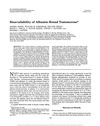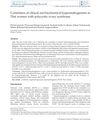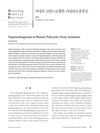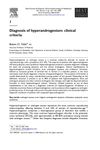TLDR Salivary testosterone is a better measure for hirsutism than serum testosterone.
The study measured testosterone levels in saliva and serum of 53 women with hirsutism and hyperandrogenism, finding that salivary testosterone (SaT) concentrations were higher than serum free testosterone (fT) levels, suggesting SaT reflects bioavailable testosterone. SaT showed a stronger correlation with the degree of hirsutism (rho = 0.45; P < 0.01) compared to serum testosterone parameters, even after accounting for body mass index effects. This indicated that SaT might be a more effective measure for studying hirsutism, as it relates to the bioavailable fraction of testosterone.
 255 citations
,
October 1985 in “The Journal of Clinical Endocrinology & Metabolism”
255 citations
,
October 1985 in “The Journal of Clinical Endocrinology & Metabolism” Spironolactone treatment increases the amount of testosterone available in the body.
18 citations
,
January 1985 in “Acta Obstetricia Et Gynecologica Scandinavica” Hirsutism severity is linked to androgen levels, especially in women with a lower LH/FSH ratio.
15 citations
,
September 1973 in “PubMed” High androgen levels often cause female hirsutism and infertility.
 14 citations
,
February 2016 in “Journal of Obstetrics and Gynaecology Research”
14 citations
,
February 2016 in “Journal of Obstetrics and Gynaecology Research” Blood tests are needed to confirm high male hormone levels in women with PCOS, as physical signs alone are not reliable.
 3 citations
,
January 2012 in “Hanyang Medical Reviews”
3 citations
,
January 2012 in “Hanyang Medical Reviews” The document concludes that more research is needed to create suitable diagnostic criteria and understand PCOS in Korean women, and genetics may allow for personalized treatment.
 85 citations
,
June 2006 in “Best Practice & Research Clinical Endocrinology & Metabolism”
85 citations
,
June 2006 in “Best Practice & Research Clinical Endocrinology & Metabolism” The document concludes that hirsutism is the main sign for diagnosing hyperandrogenism, which requires a detailed patient history and physical exam.
1 citations
,
April 1993 in “Problemy e̊ndokrinologii” Spironolactone effectively reduces symptoms of hyperandrogenism like hirsutism and acne.



